March 2025
The global digital holography market size was USD 3.69 billion in 2023, calculated at USD 4.38 billion in 2024 and is expected to be worth around USD 24.57 billion by 2034. The market is slated to expand at 18.81% CAGR from 2024 to 2034.
The digital holography market size is worth around USD 4.38 billion in 2024 and is anticipated to reach around USD 24.57 billion by 2034, growing at a CAGR of 18.81% over the forecast period 2024 to 2034. The North America digital holography market size reached USD 1.25 billion in 2023. The rising demand to convert a multidimensional object into an image revolutionizes the ways of learning, communicating, collaborating, and processing information, fueling the growth of the digital holography market.
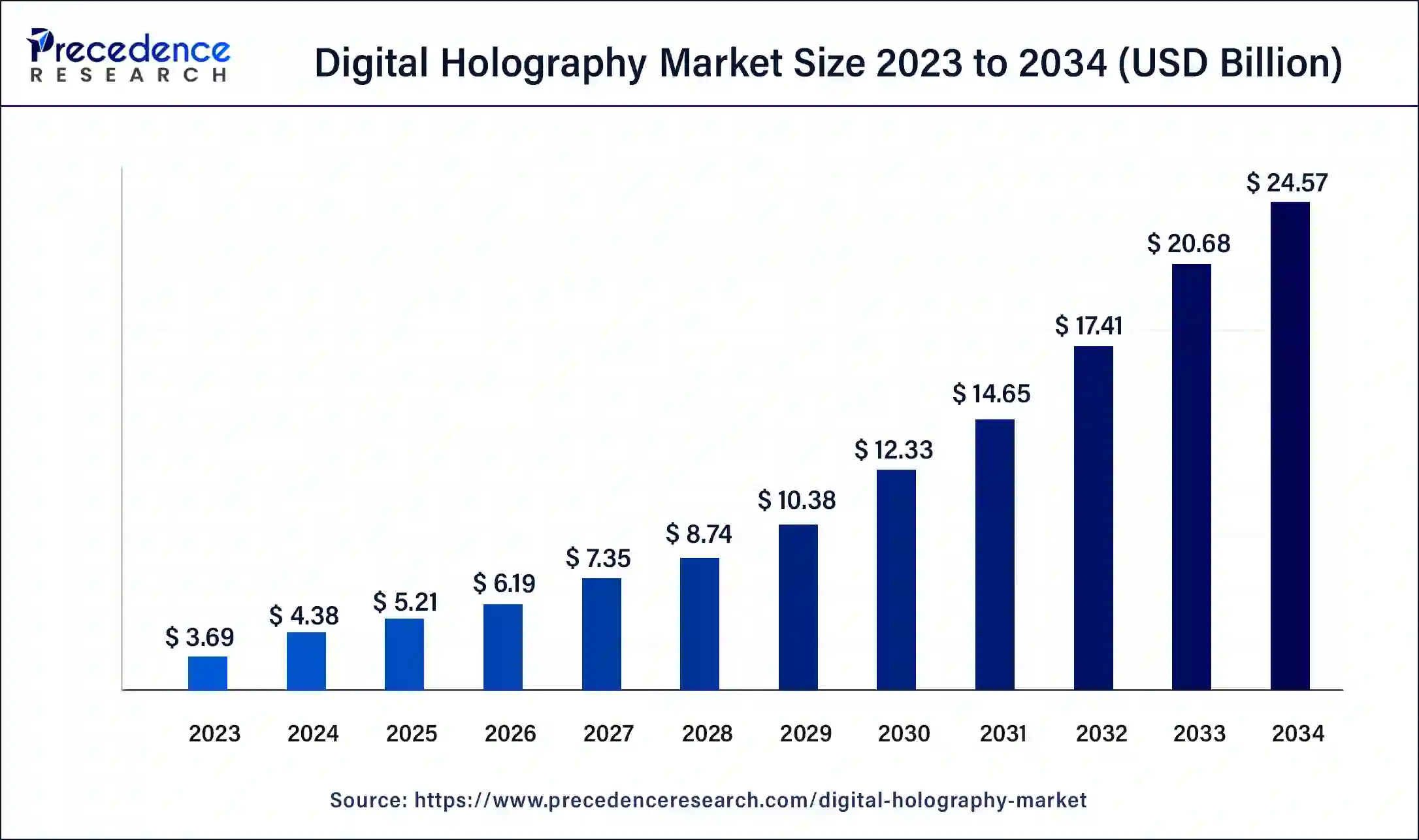
The U.S. digital holography market size was exhibited at USD 880 million in 2023 and is projected to be worth around USD 5,980 million by 2034, poised to grow at a CAGR of 19.02% from 2024 to 2034.
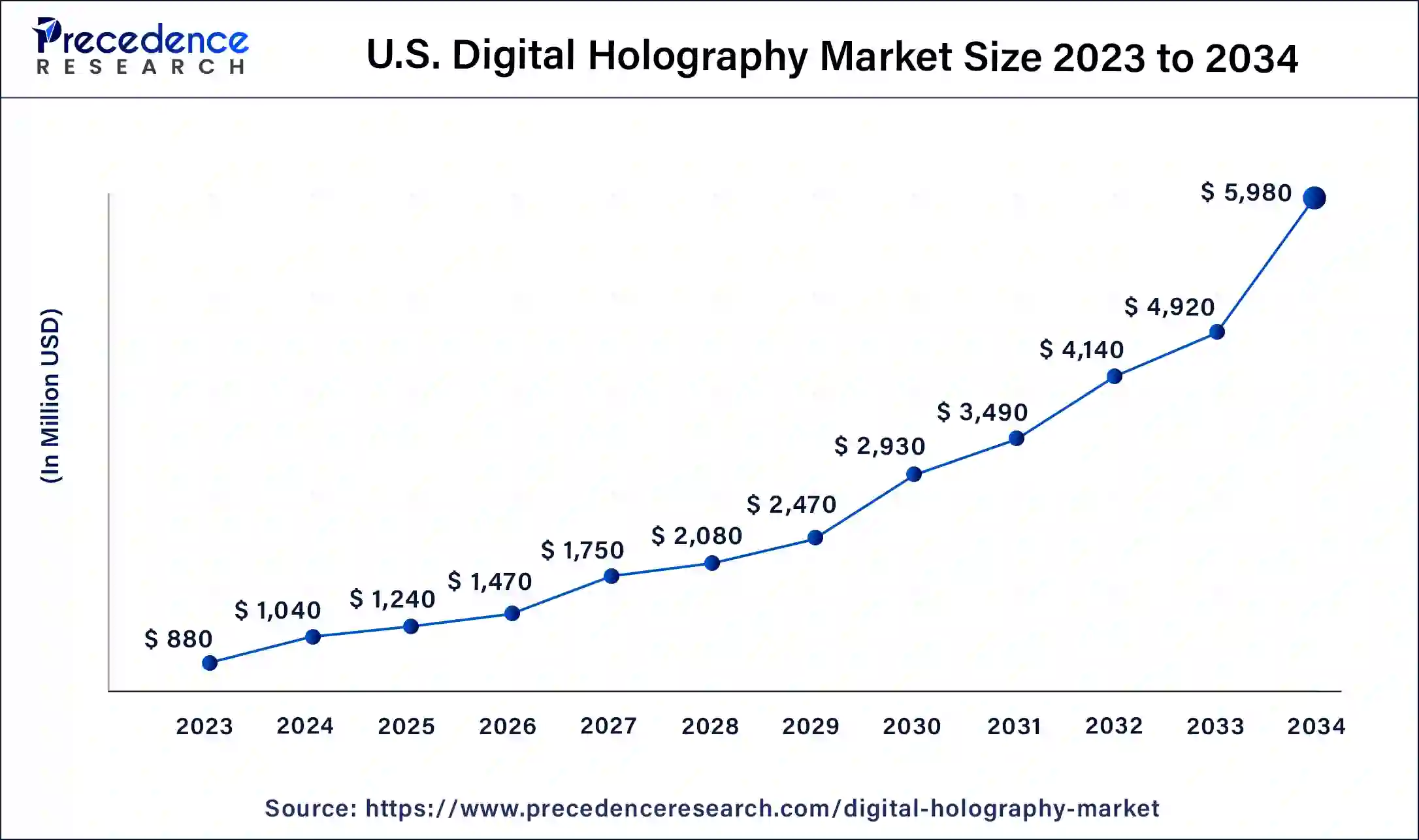
North America led the global digital holography market with the biggest market share in 2023. The increasing adoption of advanced technology of digital holography for research purposes is widely noticed in this region. The U.S. is ranked first with the largest share in this region and the second largest in Mexico, which has constantly evolving technologies. Holographic displays are increasingly being integrated within the North American region, and they consist of augmented reality (AR) and virtual reality (VR) technologies to create immersive and interactive experiences. These are the factors that help boost this region's growth.
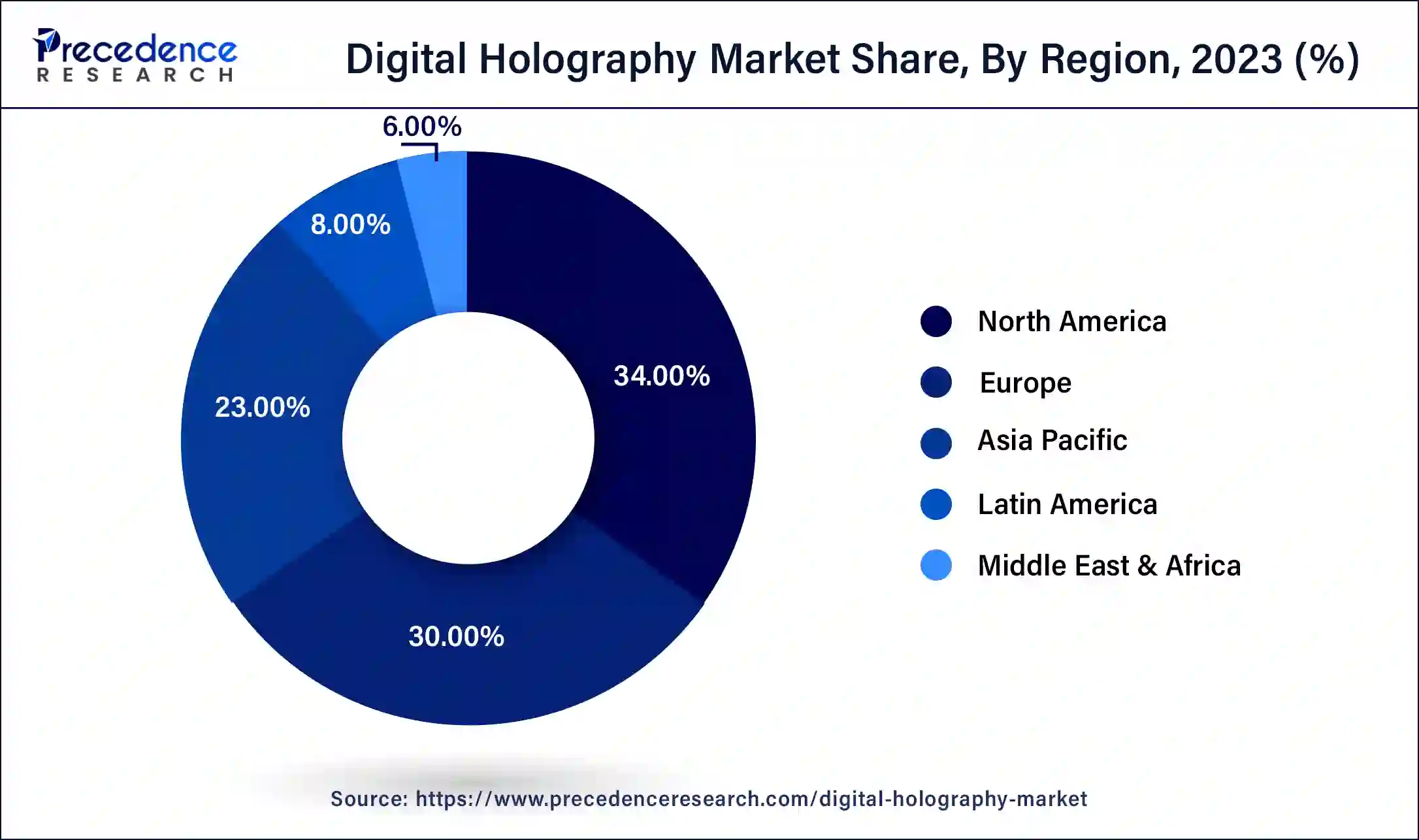
Asia-Pacific is anticipated to grow at the fastest rate during the forecast period. The growth in this region is attributed to the increasing number of manufacturers and their research and development teams, which assess the viability of the developing technology and challenge themselves to invent new generations of authentication and anti-counterfeiting methods. China is leading in the Asia Pacific region. In China, holographic projection technology is a research hotspot in various digital media technology applications that help to proliferate the Asia Pacific region widely on a large scale.
Creating a two-dimensional image from a three-dimensional object with the help of the diffraction of light technique is known as a hologram. Involving digitalization in the process uses digital arrays for the hologram method. This technique facilitates the measuring of optical phase data and delivers 3D surface or optical thickness images, which is not accomplished by digital photography.
This technique is a promising technology for 3D display and accurate sensing applications. Digital holography is used in various scientific and industrial inspections, such as microscopy, non-destructive testing, displays, environment, cloud, and ocean studies. Digital holography interferometry methods are applied to various items, products, and systems, including delicate artwork, paintings, furniture, statues, and icons, for defect detection, structural integrity, and health monitoring. It is used for inspection, quality control, and measurements in industries such as aerospace, manufacturing, automotive, energy, and cultural heritage.
How is AI changing the Digital Holography Market?
Augmented reality becomes more immersive when artificial intelligence (AI) is combined with holographic imagery and cutting-edge display technology. Unlike the bulky augmented reality headsets already on the market, researchers at Stanford University have created a prototype of augmented reality headsets that employ holographic imaging to overlay full-color, 3D moving pictures on the lenses of a regular pair of spectacles. With this innovative method, a visually captivating 3D viewing experience may be had in a small, stylish, comfy, and wearable gadget. These technologies have the power to revolutionize a wide range of industries, including gaming, entertainment, training, and education. This equipment might be used by surgeons to do intricate or delicate surgery or by airline technicians to learn about the newest jet engines.
| Report Coverage | Details |
| Market Size by 2034 | USD 24.57 Billion |
| Market Size in 2024 | USD 4.38 Billion |
| Market Growth Rate from 2024 to 2034 | CAGR of 18.81% |
| Largest Market | North America |
| Base Year | 2023 |
| Forecast Period | 2024 to 2034 |
| Segments Covered | Offering, Dimension, Application, End-use, and Regions |
| Regions Covered | North America, Europe, Asia-Pacific, Latin America and Middle East & Africa |
Interactive visualization experience
The potential to offer a captivating and immersive user experience is one of the main advantages of digital holography. Holograms offer a more lifelike experience than conventional 2D screens. These attributes are highly regarded in virtual reality, gaming, and training simulation settings. It is especially useful in fields like architecture and health, where visualization is essential since its main purpose is to simplify complicated information. Holographic organ models can be studied by surgeons; architects may explore three-dimensional holographic building displays, and scientists can perform more accurate analyses of intricate molecular structures. Digital holography facilitates dynamic information transmission in commercial settings by enabling interactive communication. Picture holograms make it easier and more entertaining to showcase ideas and products.
High Production Cost
The advanced and highly engaging visual experience technology of digital holography comes at a high production cost. The factors affecting the cost range include complexity and quality, equipment, and scale of production. A high-definition hologram requires larger resources and time for production. Thus, increase in the cost price. Utilizing cutting-edge technology and specialized types of equipment such as display devices, cameras, scanners to capture objects and digital processing tools influence the high cost. Production of large-scale or multiple holograms generally costs more because of the increased materials and labor required. For personal use, small-scale displays or entry-level holograms are suitable, and they range from $50 to $100. A commercial hologram, which is used for advertising and events, ranges from $500 to $2,000. A professional hologram used in healthcare ranges from $2,000 to over $10,000.
Futuristic Solutions
With the development of technology and new advancements, the future of digital holography looks promising in the coming years. Innovative military mapping to display a geographical layout of the battle space will provide a 3D holographic map for the soldiers to plan and strategize the battle. The maps are also useful for disaster evacuation and military rescue scenarios. The use of holograms for information storage is expected to witness.
With the increase in population and workload, there is a generation of incalculable amounts of data every day. Thus, increase in digital storage capacity. Holograms can record genuine data and store large amounts of information. This is anticipated to have a durability of more than 50 years, a storage capacity of up to 1 terabyte of data per square inch, and high-speed transfer offers of up to 1 gigabyte per second. This is expected to be a revolutionizing tool in the medicinal field for visualizing patient data in training students and surgeons. Digital holography technology is an incredible advantage for commercial security.
An advanced banknote showcasing the best in micromirror and hologram integration has won the ‘Best Applied Security Product’ category at the Excellence in Holography Awards 2023, organized by the industry trade body International Hologram Manufacturers Association (IHMA).
The hardware segment held the dominant share of the digital holography market in 2023. There are various hardware components required to build a holographic display. The main components of digital holography are laser, sensor, camera, optics, and beam splitter. Accurately designed devices are needed to provide instructions to the software to enhance performance, reliability, scalability, and customization. Some of the key players in the digital holographic market play a crucial role in manufacturing and developing the industry, such as Axiom Holographics, which provides hologram technology to military organizations globally, including the US Marines, US Air Force, Lockheed Martin, Australian Army and Airforce, and UK Defence research.
VividQ, a UK startup, claims to have created the world’s first holograms with retina resolution. VividQ expects the impact on VR and mixed reality applications — especially gaming. The company states that the holograms will offer users “unparalleled” levels of immersion and realism. VividQ is collaborating with JVCKenwood (JKC), a Japanese electronics firm, to commercialize the tech.
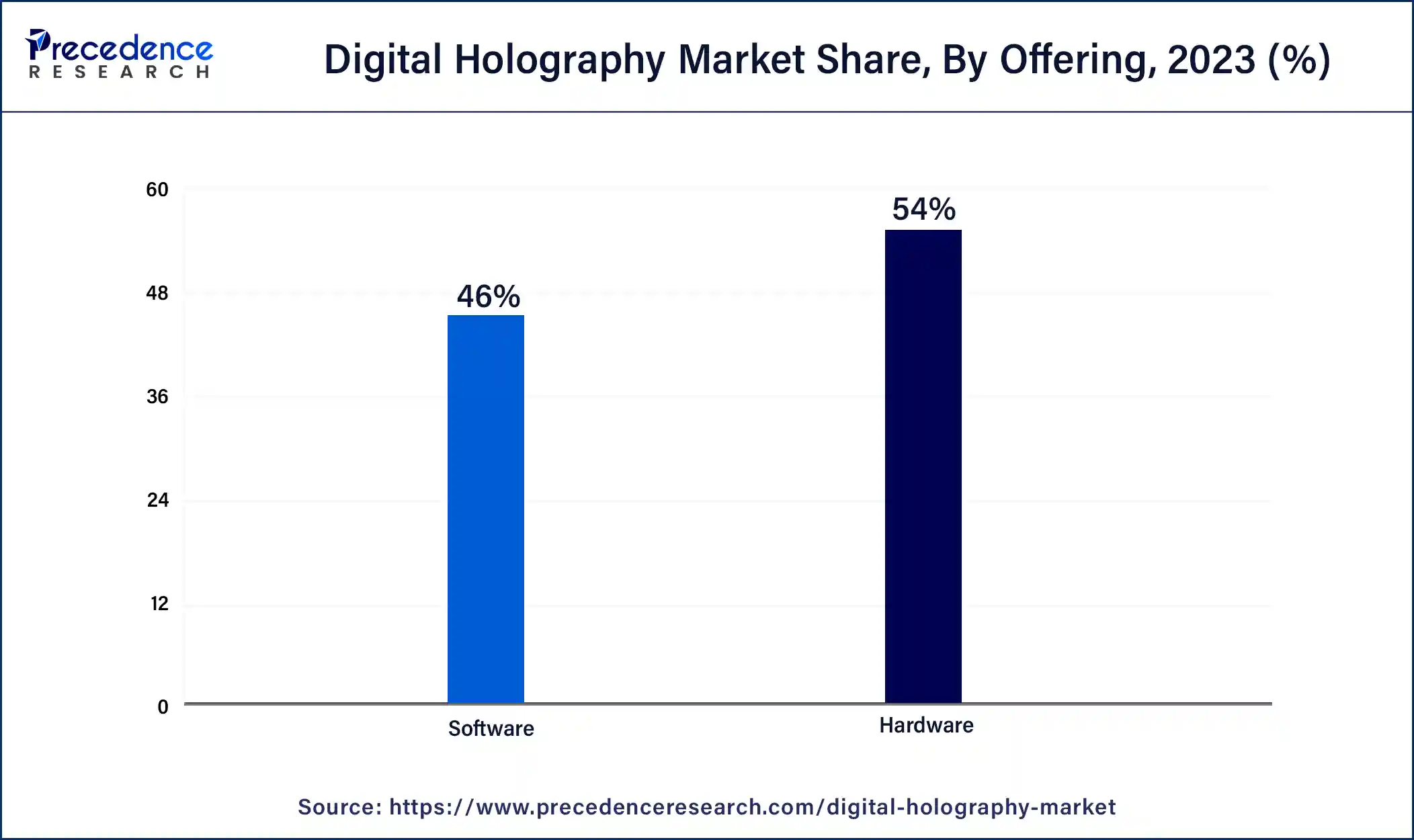
The software segment is anticipated to showcase significant growth in the digital holography market in the upcoming years. The growth in this field is due to the utilization of holograms in security, the ability to communicate complex products, provide innovative learning experiences, and create an immersive environment. The HoloLens software, owned by Microsoft, is a computer-powered headset offering sensors and lenses for a mixed-reality experience, which is a blend of virtual and reality. HoloLens is used in healthcare to train medical professionals, assist with surgeries, and improve doctor-patient communication; it is also used in education, manufacturing, entertainment, architecture and construction, remote collaboration, and retail.
The two-dimensional (2D) segment dominated the global digital holography market in 2023. The growth factor of this segment is that it creates an illusion of a 3D object when light falls on it. This photographic technique uses light beans to produce a virtual 3D image. Experts currently use 2D for medical imaging equipment. A common example of a 2D hologram in real life is a security emblem on a credit card. It is engraved by a laser onto a flat surface, providing only one good viewing angle.
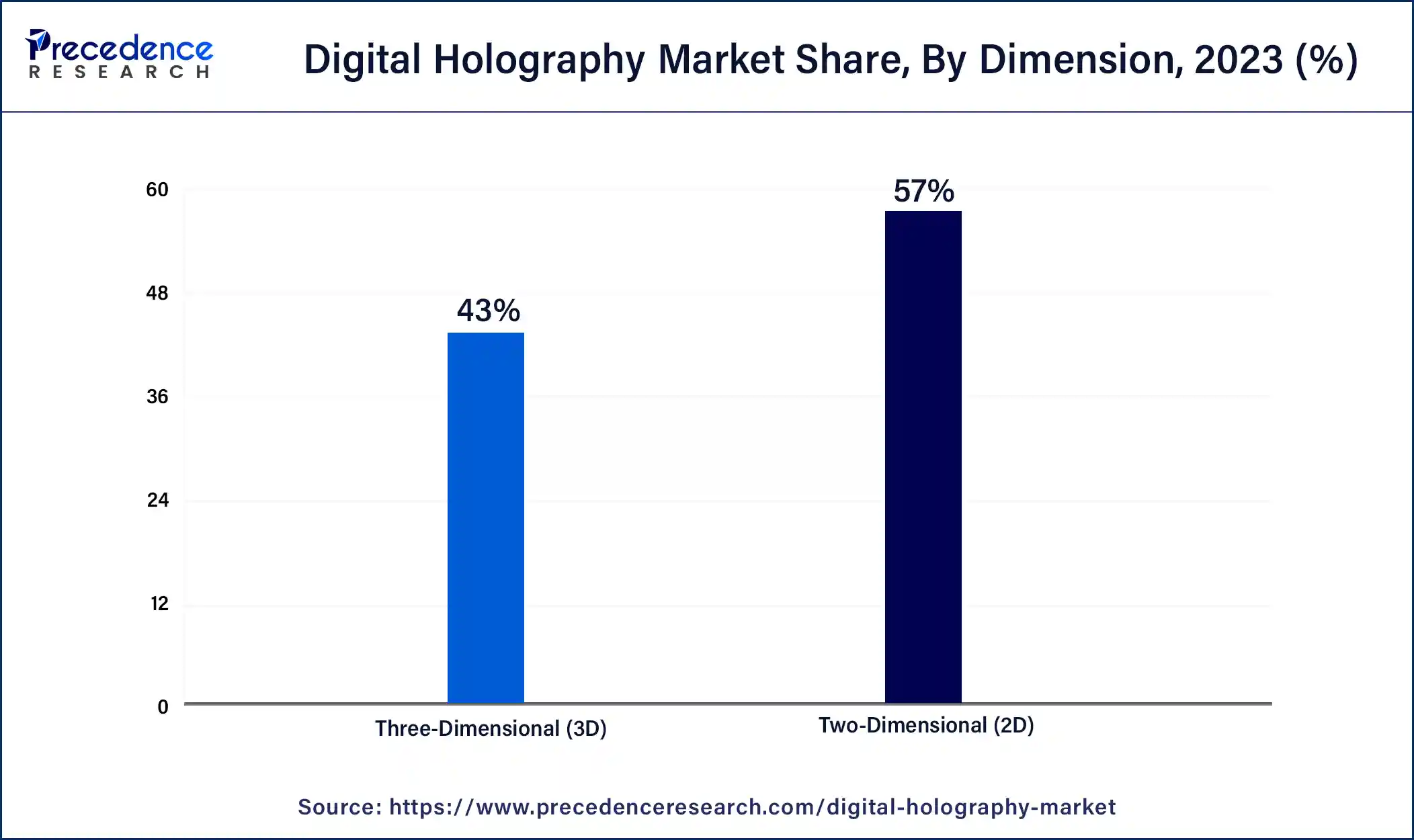
The three-dimensional (3D) segment is expected to grow at the fastest rate in the digital holography market over the forecasted years. The demanding factor about 3D holograms is that it offers realistic 3D visualization and an immersive experience. It is utilized in the fields of entertainment, security, research, and data storage. It provides secure identification features that are hard to counterfeit. A 3D hologram that can be observed from any viewing angle as it is projected into a three-dimensional space. A 3D image provides significantly more information than a 2D image.
The holographic microscopy segment accounted for the largest share of the digital holography market in 2023. A holographic microscope is a fast-imaging method that is illuminated by laser light, resulting in a 3D structure, position, and orientation in a microscope. A projected image of the specimen is not recreated; instead, it produces a digital hologram with the help of the light waves that have passed by the specimen. This technique is applied in the quantitative study of cellular dynamics and imaging of different cell types, such as ovarian cancer cells, fibroblast cells, testate amoeba, diatom skeletons, and red blood cells.
The holographic imaging segment is expected to grow at the fastest rate in the digital holography market during the foreseeable period. Holographic imaging is a powerful tool for the measurement of optical wavefront and quantitative phase imaging. This technique involves recording and reconstructing light waves to create a 3D dimensional image of an object. In industrial applications, holographic technology is used for quality control in manufacturing and fracture testing. In a medical setting, it is used for MRI, CT scans, and much more medical imaging; it is also used for surgical planning and training, tumor visualization, and telemedicine. In the security field, it provides biometric authentication, secures data storage, and detects counterfeits.
The healthcare segment accounted for the largest share of the digital holography market in 2023. Medical imaging has been transformed by holograms, enabling the creation of full-color 3D body representations. By using this technique, healthcare professionals are able to view organs like brains, hearts, livers, and nerves in vivid detail during diagnosis and treatment. The application of digital holographic microscopy in surgical planning provides surgeons with a comprehensive view during operation planning, as well as allows them to observe subcellular movements deep within living tissues and count cells.
The education segment is anticipated to be the fastest-growing in the digital holography market during the predicted period. It is capable of enhancing the learning and teaching methodologies, especially when it comes to virtual classroom sessions. Holographic images help students to understand complex concepts by displaying realistic and interactive representations. For instance, it can explain chemical reactions, biological processes, historical events, and mathematical models. This brings a fun and engaging way of interacting for students with the help of immersive games and stories. Digital holography allows effective communication between teachers and peers to explore new possibilities of creativity.
Segments Covered in the Report
By Offering
By Dimension
By Application
By End-use
By Geography
For inquiries regarding discounts, bulk purchases, or customization requests, please contact us at sales@precedenceresearch.com
No cookie-cutter, only authentic analysis – take the 1st step to become a Precedence Research client
March 2025
January 2025
January 2025
August 2024